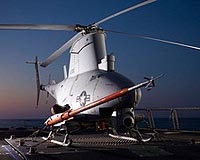| . |  |
. |
St. Louis MO (SPX) May 12, 2009 Boeing plans to develop and demonstrate an unmanned flying test bed for advanced air system technologies. The internally funded program, called Phantom Ray, will use the prototype vehicle that Boeing originally developed for the Defense Advanced Research Projects Agency (DARPA)/U.S. Air Force/U.S. Navy Joint-Unmanned Combat Air System (J-UCAS) program. The Phantom Ray demonstrator is scheduled to make its first flight in December 2010. The aircraft will conduct 10 flights over a period of approximately six months, supporting missions that may include intelligence, surveillance and reconnaissance; suppression of enemy air defenses; electronic attack; hunter/killer; and autonomous aerial refueling. The Boeing Phantom Works organization is employing rapid-prototyping techniques that facilitate the speed and agility needed to meet the 2010 flight schedule. "Boeing's goals for the Phantom Ray program clearly demonstrate our commitment to rapid prototyping and are an important part of the company's efforts to be a leader in the unmanned aircraft business," said Phantom Works President Darryl Davis. "We have mobilized our assets to continue the tremendous potential we developed under J-UCAS, and now will fully demonstrate that capability." Phantom Ray will pick up where the UCAS program left off in 2006 by further demonstrating Boeing's unmanned systems development capabilities in a fighter-sized, state-of-the-art aerospace system. The Boeing UCAS program began with the X-45A, which successfully flew 64 times from 2002 to 2005. Those flights included a demonstration exercise with two X-45A aircraft that marked the first unmanned, autonomous multivehicle flight under the control of a single pilot. Boeing also designed a larger UCAS aircraft, the X-45C, which will serve as the basis for the Phantom Ray demonstrator. "What is particularly exciting about Phantom Ray is that we will incorporate the latest technologies into the superb X-45C airframe design," said Dave Koopersmith, vice president of Boeing Advanced Military Aircraft, a division of Phantom Works. "As we gradually expand the vehicle's flight envelope, potential users will have access to a full range of unique capabilities that only this type of autonomous platform can provide." Lab testing for the Phantom Ray air vehicle is scheduled for late 2009, followed by ground testing and first flight in 2010. Share This Article With Planet Earth
Related Links Boeing Integrated Defense Systems UAV News - Suppliers and Technology
 MQ-8B Fire Scout Completes Second Test Period Onboard USS McInerney
MQ-8B Fire Scout Completes Second Test Period Onboard USS McInerneySan Diego CA (SPX) May 11, 2009 A Northrop Grumman-developed MQ-8B Fire Scout Vertical Takeoff and Landing Tactical Unmanned Aerial Vehicle (VTUAV) successfully completed fully autonomous flight operations onboard the USS McInerney (FFG-8) frigate. These operations marked the first time that the Navy operated an autonomous VTUAV aboard a surface combatant vessel. This follows at-sea operations aboard the USS Nashvi ... read more |
|
| The content herein, unless otherwise known to be public domain, are Copyright 1995-2009 - SpaceDaily. AFP and UPI Wire Stories are copyright Agence France-Presse and United Press International. ESA Portal Reports are copyright European Space Agency. All NASA sourced material is public domain. Additional copyrights may apply in whole or part to other bona fide parties. Advertising does not imply endorsement,agreement or approval of any opinions, statements or information provided by SpaceDaily on any Web page published or hosted by SpaceDaily. Privacy Statement |